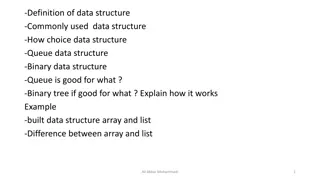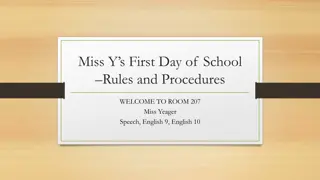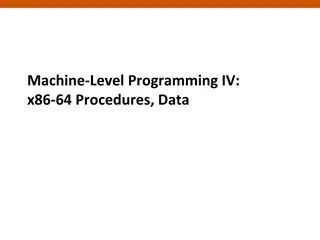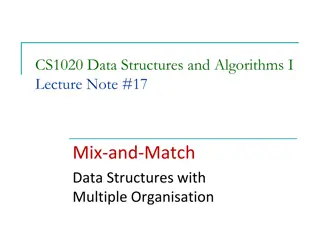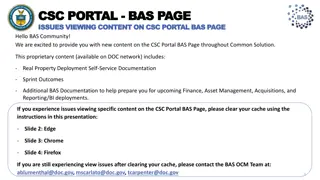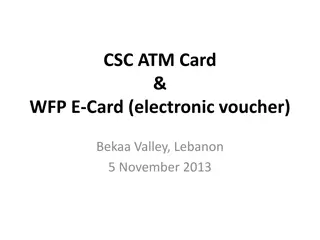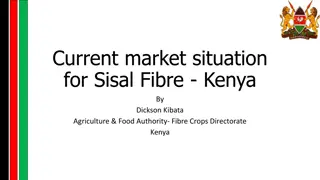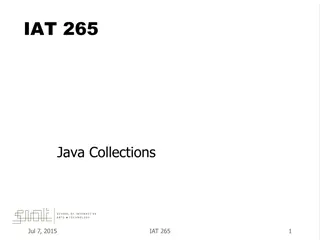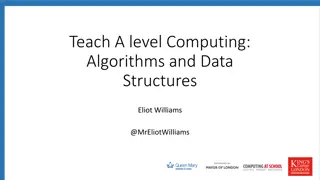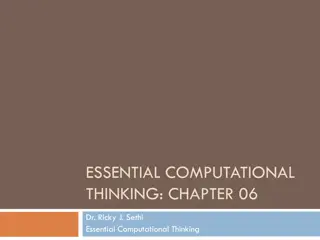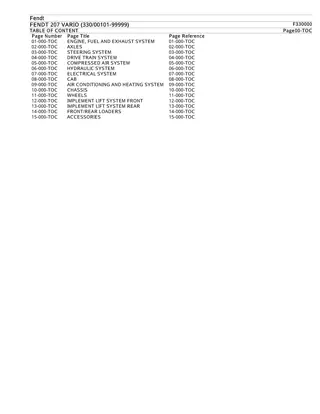Understanding Data Structures in CSC 207 with Dr. Olatunji K. A.
This course covers the objectives, learning outcomes, and contents related to data structures in CSC 207. Students will learn about data type specifications, representation techniques, algorithm analysis, recursive methods, and practical applications of data structures. The course delves into basic terminologies, data organization, abstract data types, arrays, linked lists, stacks, queues, trees, and graphs. By the end of the lectures, students should grasp data representation, algorithm manipulation, and structure implementations, paving the way for a comprehensive understanding of data structures.
Download Presentation

Please find below an Image/Link to download the presentation.
The content on the website is provided AS IS for your information and personal use only. It may not be sold, licensed, or shared on other websites without obtaining consent from the author. Download presentation by click this link. If you encounter any issues during the download, it is possible that the publisher has removed the file from their server.
E N D
Presentation Transcript
CSC 207: Data Structures TUTOR: DR. (MRS) OLATUNJI K. A.
Objectives of Data Structures The objectives of this study are to make students understand: Specification, representation, and implementation of data types and data structures Basic techniques of algorithm analysis, recursive methods. Applications of Data Structures Provide example use for these structures. Show how to implement some of the structures and its operations.
Learning Outcomes At the end of the lectures students should be able to understand: Ways to represent data and Algorithms to manipulate these representations. How to implement some of the structures and its operations
Course Contents Basic Terminologies Elementary Data Organization Algorithm Abstract Data Types (ADT) Arrays: Definition, Single and Multidimensional Arrays, Representation of Arrays: Row Major Order, and Column Major Order, Application of arrays.
Course Contents Contd. Linked lists: Array Implementation and Dynamic Implementation of Singly Linked Lists, Doubly Linked List, Circularly Linked List, Operations on a Linked List. Insertion, Deletion, Traversal. Stacks: Abstract Data Type, Primitive Stack operations: Push & Pop, Array and Linked Implementation of Stack in C, Application of stack: Queue: Operations on Queue: Create, Add, Delete, Full and Empty, Circular queues, Array and linked implementation of queues in C, Dequeue .
Course Contents Contd. Trees: Basic terminology, Binary Trees, Binary Tree Representation: Array Representation and Dynamic Representation, Complete Binary Tree, Array and Linked Representation of Binary trees, Tree Traversal algorithms: Inorder, Preorder and Postorder Graphs: Terminology, Representations of Graphs: Adjacency Matrices, Adjacency List, Adjacency Multi list, Graph Traversal : Depth First Search and Breadth First Search, Connected Component, Spanning Trees, Sequential and linked
Basic Terminologies What is data?: Data are simply collection of facts and figures. Data are values or set of values. Data is a set of elementary items A data item refers to a single unit of values. Group items are data items that are divided into sub item; Elementary items are those items that are not divided into sub item. For example, an employee s name may be divided into three sub items [first name, middle name and last name] but employee s ID would normally be treated as a single item.
Work to do: Structure the following into group or elementary items: Name, ID, Age, Gender, First, Middle, Last, Street, Area, Address
Data Type Data type is a classification identifying one of various types of data, such as floating-point, integer, or Boolean, that determines the possible values for that type; the operations that can be done on values of that type; and the way values of that type can be stored.
Data Type is of two types: Primitive and non-primitive data type. Primitive data type is the basic data type that is provided by the programming language with built-in support. This data type is native to the language and is supported by machine directly. For example: int, float, char, double. Non-primitive data type is derived from primitive data type. For example- array, linked list, structure etc.
Variable It is a symbolic name given to some known or unknown quantity or information, for the purpose of allowing the name to be used independently of the information it represents. A variable name in computer source code is usually associated with a data storage location and thus also its contents. Variable may change during the course of program execution.
Record: Collection of related data items is known as record. Program: this is a sequence of instructions that a computer can interpret and execute. Entity: An entity is something that has certain attributes or properties which may be assigned some values. The values themselves may be either numeric or non-numeric. For example: Attributes: Name Age Gender Phone Number Values: Ola 22 Male 0812 3676 002 Funmi 21 Female 0809 5553 231 Solomon 20 Male 0803 4621 889
Entity Set: An entity set is a group of or set of similar entities. For example, employees of an organization, students of a class etc. Each attribute of an entity set has a range of values, the set of all possible values that could be assigned to the particular attribute. Information: information is sometimes used for data with given attributes or processed data. Field: A field is a single elementary unit of information representing an attribute of an entity.
File: File is a collection of records of the entities in a given entity set. For example, file containing records of students of a particular class. Key: A key is one or more field(s) in a record that take(s) unique values and can be used to distinguish one record from the others. Algorithm: It can be defined as sequence of computational steps that transform the input into the output.
An algorithm can be expressed in three ways:- (i) in any natural language such as English, called pseudo code. (ii) in a programming language or (iii) in the form of a flowchart. EFFICIENCY OF AN ALGORITHM In computer science, algorithmic efficiency are the properties of an algorithm which relate to the amount of resources used by the algorithm. An algorithm must be analyzed to determine its resource usage.
For maximum efficiency there is need to minimize resource usage. However, the various resources (e.g. time, space) can not be compared directly, so if two algorithms are being compared-which of two algorithms is considered to be more efficient often depends on which measure of efficiency is being considered as the most important, e.g. is the requirement for high speed, or for minimum memory usage, or for some other measure.
It can be of various types: Worst case efficiency: It is the maximum number of steps that an algorithm can take for any collection of data values. Best case efficiency: It is the minimum number of steps that an algorithm can take any collection of data values. Average case efficiency: It can be defined as - the efficiency averaged on all possible inputs - must assume a distribution of the input - We normally assume uniform distribution (all keys are equally probable) If the input has size n, efficiency will be a function of n
TIME AND SPACE COMPLEXITY Complexity of algorithm is a function of size of input of a given problem instance which determines how much running time/memory space is needed by the algorithm in order to run to completion. Time Complexity: Time complexity of an algorithm is the amount of time it needs in order to run to completion. Space Complexity: Space Complexity of an algorithm is the amount of space it needs in order to run to completion.
Abstract Data Type It can be defined as a collection of data items together with the operations on the data. The word abstract refers to the fact that the data and the basic operations defined on it are being studied independently of how they are implemented. It involves what can be done with the data, not how has to be done
ADT Contd. An Example: Collections Programs often deal with collections of items. These collections may be organized in many ways and use many different program structures to represent them, yet, from an abstract point of view, there will be a few common operations on any collection. These might include:
Data Structure A data structure is a particular way of storing and organizing data in a computer s memory so that it can be used efficiently. A data structure is a logical or mathematical model of a particular organization of data. Need of data structure It gives different level of data organization. It tells how data can be stored and accessed in its elementary level. Provide operation on group of data, such as adding an item, looking up highest priority item. Provide a means to manage huge amount of data efficiently. Provide fast searching and sorting of data.
Selecting a data structure Selection of suitable data structure involve following steps: Analyze the problem to determine the resource constraints a solution must meet. Determine basic operation that must be supported. Quantify resource constraint for each operation Select the data structure that best meets these requirements. Each data structure has cost and benefits. Rarely is one data structure better than other in all situations. A data structure require : Space for each item it stores Time to perform each basic operation Programming effort. Each problem has constraints on available time and space. Best data structure for the task requires careful analysis of problem characteristics. Assignment: write short note on types of data structures (linear, non linear, dynamic and static data structures)







